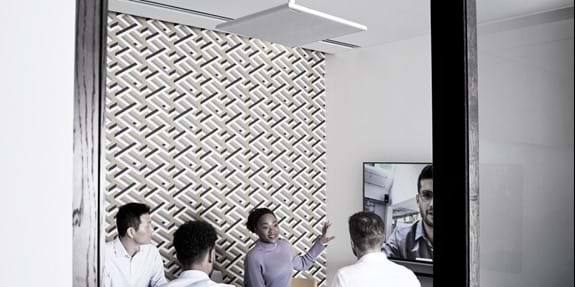MEETING ROOM DESIGN - HOW TO GET YOUR AUDIO RIGHT
Audio quality in meeting room spaces should be one of the top priorities for businesses when designing contemporary work environments.

Why you can’t afford poor meeting audio
Professionals expect a high level of success from their conference room audio. Employees have a low tolerance for poor audio quality in the workspace because of the prevalence of effective mobile technologies in their personal lives. If audio isn’t factored into development plans at the beginning of a meeting room’s build, then it’s likely to have high costs in the long-term. Here’s how it could impact your business:
Explore our reasons why
Unprofessional reputation
Poor audio experiences during customer facing meetings can have a negative impact on a company’s perception among external suppliers.
Employee dissatisfaction
Staff morale can be impacted by poor internal audio conferencing solutions.
Wasted budget
Retrofitting audio solutions will hit budgets as applying room fixes can be both time-consuming and expensive. To help, we’ve put together an overview of what you need to consider when designing the perfect audio environment for meeting rooms. This essential advice should help avoid additional retrofitting costs as well as ensure audio does its best to enhance rather than ruin the reputation of your business.
Audio should be a priority from the start of a room design
It’s important to consider audio during the very initial stages of a meeting room design or build project. Troubleshooting audio issues and implementing fixes can be undertaken at the culmination of a build but it’s always more cost effective to consider them at the start. Make sure the project team is fully briefed and open to collaborating with audio experts from the get go.
Hire an acoustics expert
Employ an acoustic expert and involve them early on with the project team’s plans. Ensure they work closely with the architect, interior designers and building service consultants on planning a space.
Consider background noise from air conditioning or heating units
Make sure any background noise from Heating, Ventilation and Air Conditioning (HVAC) units are thought about during the build. Your acoustic consultant should be briefed on plans around these background noise sources early on.
It’s also important to remember many HVAC units now focus on reducing energy usage. So when room occupancy is low, they ramp down and reduce noise levels. This can lead to a significant variation between noise levels depending on how a meeting room is used.
Make your meeting room spaces as inclusive as possible
Meeting rooms need to be comfortable for users of all kinds. So while users may prefer acoustics to be more lively, other users may struggle to understand speech in such a meeting room environment, especially if it has a high level of background noise.
So during the room design, the effects of a lack of acoustic finishes need to be considered. Rooms with too many sound absorbent finishes can sometimes be uncomfortable to be used for long periods of time.
Adhere to the RIBA work plan
Most projects adhere to the RIBA’s Plan of Work, a definitive model for the building, design and construction process. However, it’s important for the project team to stay abreast of this and adhere to this design process where possible. A current trend among some developers is for certain stages to be ignored or combined in an attempt to save money or speed up a build. It can lead to audio design issues at a later date so it’s best practice to follow these steps as closely as possible.
Think about meeting room materials
Current trends for room design include exposed soffits and high level services, both of which can make room acoustics challenging due to their lack of sound absorption.
Using glass also creates a number of issues in the workplace. Not only does it lead to meetings being subject to external distractions but secure information is at risk of being seen from outside a room too. From an acoustics perspective, it’s impossible to treat so any use of glass is best to be limited to one wall if not at all. Thinking about how you mitigate reverb and noise build up is important in these scenarios.
Lighting
Lighting often takes precedence over acoustics or audio equipment when it comes to room design. In many scenarios, the fixing of lighting to the ceiling limits the amount of space that can be afforded to ceiling loudspeakers and microphones such as Shure’s Microflex® Advance™ MXA910 Ceiling Array Microphone.
Remember that a good meeting space strikes the right balance between lighting, audio and video rather than favoring one at the expense of the others.
Always demo and test audio solutions
It’s very important to test and demo any audio solutions before implementing them in your room design.
Large organisations should continually proof and test. Following this process will help increase the chances of utilizing effective audio solutions across all spaces when scaling up for a business.
Conclusion
When designing a meeting room, there are plenty of considerations to be factored into the plans but never forget the importance of audio and acoustics. Other aspects of room design are visual so are arguably easier for room designers to remember and prioritize. But audio should always be a top concern. Involving an acoustics consultant early on doesn’t need to be expensive and should hopefully save costs down the line. It should increase the chances of your meeting rooms not only being comfortable and easy to use but benefit from the best possible audio solution for your space.

Related Posts
Frost & Sullivan Analyst Gauntlet MXA902
We're excited to announce that the Shure MXA902 has successfully navigated the Frost & Sullivan Analyst Gauntlet. Check out all the details here.
Is it time you paid attention to your employee audio experience?
With IDC research showing that 72% of companies that are thriving financially using professional audio equipment and software to enhance their experiences in meetings, download this information to find out why even a small investment will have a significant impact from the first meeting to the last.